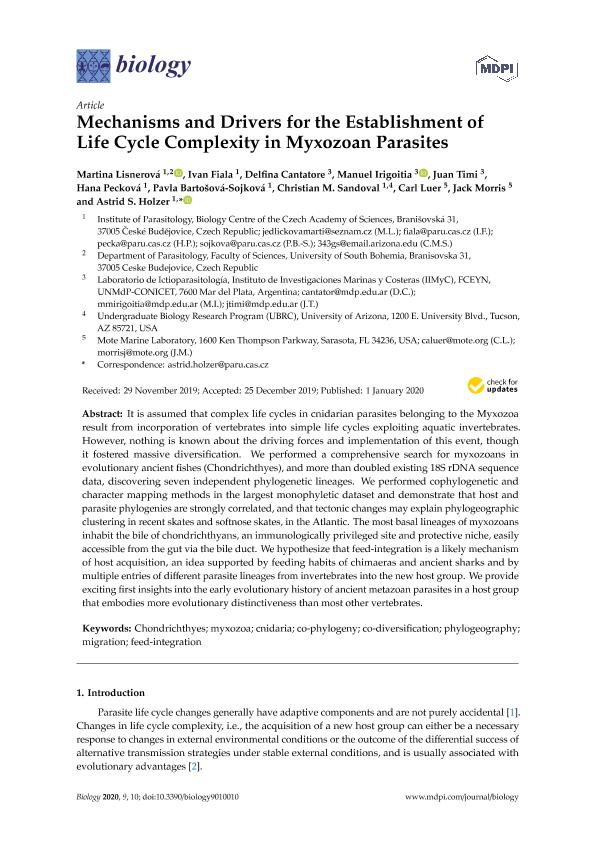Artículo
Mechanisms and drivers for the establishment of life cycle complexity in Myxozoan parasites
Lisnerová, Martina; Fiala, Ivan; Cantatore, Delfina María Paula ; Irigoitia, Manuel Marcial
; Irigoitia, Manuel Marcial ; Timi, Juan Tomas
; Timi, Juan Tomas ; Pecková, Hana; Bartoová Sojková, Pavla; Sandoval, Christrian M.; Luer, Carl; Morris, Jack; Holzer, Astrid Sybylle
; Pecková, Hana; Bartoová Sojková, Pavla; Sandoval, Christrian M.; Luer, Carl; Morris, Jack; Holzer, Astrid Sybylle
 ; Irigoitia, Manuel Marcial
; Irigoitia, Manuel Marcial ; Timi, Juan Tomas
; Timi, Juan Tomas ; Pecková, Hana; Bartoová Sojková, Pavla; Sandoval, Christrian M.; Luer, Carl; Morris, Jack; Holzer, Astrid Sybylle
; Pecková, Hana; Bartoová Sojková, Pavla; Sandoval, Christrian M.; Luer, Carl; Morris, Jack; Holzer, Astrid Sybylle
Fecha de publicación:
01/2020
Editorial:
Multidisciplinary Digital Publishing Institute
Revista:
Biology
e-ISSN:
2079-7737
Idioma:
Inglés
Tipo de recurso:
Artículo publicado
Clasificación temática:
Resumen
It is assumed that complex life cycles in cnidarian parasites belonging to the Myxozoa result from incorporation of vertebrates into simple life cycles exploiting aquatic invertebrates. However, nothing is known about the driving forces and implementation of this event, though it fostered massive diversification. We performed a comprehensive search for myxozoans in evolutionary ancient fishes (Chondrichthyes), and more than doubled existing 18S rDNA sequence data, discovering seven independent phylogenetic lineages. We performed cophylogenetic and character mapping methods in the largest monophyletic dataset and demonstrate that host and parasite phylogenies are strongly correlated, and that tectonic changes may explain phylogeographic clustering in recent skates and softnose skates, in the Atlantic. The most basal lineages of myxozoans inhabit the bile of chondrichthyans, an immunologically privileged site and protective niche, easily accessible from the gut via the bile duct. We hypothesize that feed-integration is a likely mechanism of host acquisition, an idea supported by feeding habits of chimaeras and ancient sharks and by multiple entries of different parasite lineages from invertebrates into the new host group. We provide exciting first insights into the early evolutionary history of ancient metazoan parasites in a host group that embodies more evolutionary distinctiveness than most other vertebrates.
Archivos asociados
Licencia
Identificadores
Colecciones
Articulos(IIMYC)
Articulos de INSTITUTO DE INVESTIGACIONES MARINAS Y COSTERAS
Articulos de INSTITUTO DE INVESTIGACIONES MARINAS Y COSTERAS
Citación
Lisnerová, Martina; Fiala, Ivan; Cantatore, Delfina María Paula; Irigoitia, Manuel Marcial; Timi, Juan Tomas; et al.; Mechanisms and drivers for the establishment of life cycle complexity in Myxozoan parasites; Multidisciplinary Digital Publishing Institute; Biology; 9; 1; 1-2020; 1-16
Compartir
Altmétricas



